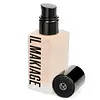Il Makiage GL Radiant Glow Woke Up Like This Foundation Versus Neutrogena SkinClearing Blemish Concealer
What's inside
What's inside
 Key Ingredients
Key Ingredients

 Benefits
Benefits

 Concerns
Concerns

 Ingredients Side-by-side
Ingredients Side-by-side

Water
Skin ConditioningCyclopentasiloxane
EmollientIsododecane
EmollientGlycerin
HumectantAlcohol
AntimicrobialPhenyl Trimethicone
Skin ConditioningAluminum Starch Octenylsuccinate
AbsorbentBis-Hydroxyethoxypropyl Dimethicone/Ipdi Copolymer Ethylcarbamate
Cetyl PEG/PPG-10/1 Dimethicone
EmulsifyingDisteardimonium Hectorite
StabilisingSodium Chloride
MaskingPolyglyceryl-4 Isostearate
EmulsifyingHexyl Laurate
EmollientDi-C12-13 Alkyl Tartrate
EmollientSodium Dehydroacetate
PreservativePotassium Sorbate
PreservativeDisodium Stearoyl Glutamate
CleansingDiamond Powder
AbrasiveCaprylic/Capric Triglyceride
MaskingAluminum Hydroxide
EmollientPentaerythrityl Tetra-Di-T-Butyl Hydroxyhydrocinnamate
AntioxidantRubus Idaeus Leaf Cell Culture
Skin ConditioningCI 77891
Cosmetic ColorantCI 77491
Cosmetic ColorantCI 77492
Cosmetic ColorantCI 77499
Cosmetic ColorantWater, Cyclopentasiloxane, Isododecane, Glycerin, Alcohol, Phenyl Trimethicone, Aluminum Starch Octenylsuccinate, Bis-Hydroxyethoxypropyl Dimethicone/Ipdi Copolymer Ethylcarbamate, Cetyl PEG/PPG-10/1 Dimethicone, Disteardimonium Hectorite, Sodium Chloride, Polyglyceryl-4 Isostearate, Hexyl Laurate, Di-C12-13 Alkyl Tartrate, Sodium Dehydroacetate, Potassium Sorbate, Disodium Stearoyl Glutamate, Diamond Powder, Caprylic/Capric Triglyceride, Aluminum Hydroxide, Pentaerythrityl Tetra-Di-T-Butyl Hydroxyhydrocinnamate, Rubus Idaeus Leaf Cell Culture, CI 77891, CI 77491, CI 77492, CI 77499
Water
Skin ConditioningCyclopentasiloxane
EmollientDimethicone
EmollientKaolin
AbrasiveCyclomethicone
EmollientVp/Hexadecene Copolymer
Synthetic Wax
AbrasiveCetyl PEG/PPG-10/1 Dimethicone
EmulsifyingTrisiloxane
Skin ConditioningBis-PEG/PPG-14/14 Dimethicone
EmollientCyclohexasiloxane
EmollientButylene Glycol
HumectantSilica
AbrasivePhenoxyethanol
PreservativeBoron Nitride
AbsorbentPolysilicone-11
Quaternium-90 Bentonite
Sodium Chloride
MaskingMagnesium Sulfate
Propylene Glycol
HumectantMethylparaben
PreservativeFarnesol
PerfumingChamomilla Recutita Flower Extract
MaskingPropylene Carbonate
SolventTriethoxycaprylylsilane
Propylparaben
PreservativeAloe Barbadensis Leaf Juice
Skin ConditioningPolymethyl Methacrylate
Tocopheryl Acetate
AntioxidantCocamidopropyl Pg-Dimonium Chloride Phosphate
Cetyl Lactate
EmollientC12-15 Alkyl Lactate
EmollientBenzalkonium Chloride
AntimicrobialRetinyl Palmitate
Skin ConditioningPantothenic Acid
Skin ConditioningAscorbic Acid
AntioxidantTitanium Dioxide
Cosmetic ColorantIron Oxides
Water, Cyclopentasiloxane, Dimethicone, Kaolin, Cyclomethicone, Vp/Hexadecene Copolymer, Synthetic Wax, Cetyl PEG/PPG-10/1 Dimethicone, Trisiloxane, Bis-PEG/PPG-14/14 Dimethicone, Cyclohexasiloxane, Butylene Glycol, Silica, Phenoxyethanol, Boron Nitride, Polysilicone-11, Quaternium-90 Bentonite, Sodium Chloride, Magnesium Sulfate, Propylene Glycol, Methylparaben, Farnesol, Chamomilla Recutita Flower Extract, Propylene Carbonate, Triethoxycaprylylsilane, Propylparaben, Aloe Barbadensis Leaf Juice, Polymethyl Methacrylate, Tocopheryl Acetate, Cocamidopropyl Pg-Dimonium Chloride Phosphate, Cetyl Lactate, C12-15 Alkyl Lactate, Benzalkonium Chloride, Retinyl Palmitate, Pantothenic Acid, Ascorbic Acid, Titanium Dioxide, Iron Oxides
 Reviews
Reviews

Ingredients Explained
These ingredients are found in both products.
Ingredients higher up in an ingredient list are typically present in a larger amount.
This ingredient is a high molecular weight silicone. It has emulsifying and skin conditioning properties.
Cyclopentasiloxane, or D5, is a silicone used to improve texture of products and trap moisture.
D5 is considered lightweight and volatile. Volatile means it evaporates quickly after application. Once evaporated, D5 leaves a thin barrier that helps keep skin hydrated.
It is also an emollient. Emollients help soften the skin and prevent water loss. Silicones create a silky texture in products. D5 helps other ingredients become more spreadable.
Studies show D5 is safe to use in skincare products. We recommend speaking with a skincare professional if you have concerns.
Learn more about CyclopentasiloxaneChances are, you eat sodium chloride every day. Sodium Chloride is also known as table salt.
This ingredient has many purposes in skincare: thickener, emulsifier, and exfoliator.
You'll most likely find this ingredient in cleansers where it is used to create a gel-like texture. As an emulsifier, it also prevents ingredients from separating.
There is much debate on whether this ingredient is comedogenic. The short answer - comedogenic ratings don't tell the whole story. Learn more about comegodenic ratings here.
The concensus about this ingredient causing acne seems to be divided. Research is needed to understand if this ingredient does cause acne.
Scrubs may use salt as the primary exfoliating ingredient.
Learn more about Sodium ChlorideWater. It's the most common cosmetic ingredient of all. You'll usually see it at the top of ingredient lists, meaning that it makes up the largest part of the product.
So why is it so popular? Water most often acts as a solvent - this means that it helps dissolve other ingredients into the formulation.
You'll also recognize water as that liquid we all need to stay alive. If you see this, drink a glass of water. Stay hydrated!
Learn more about Water